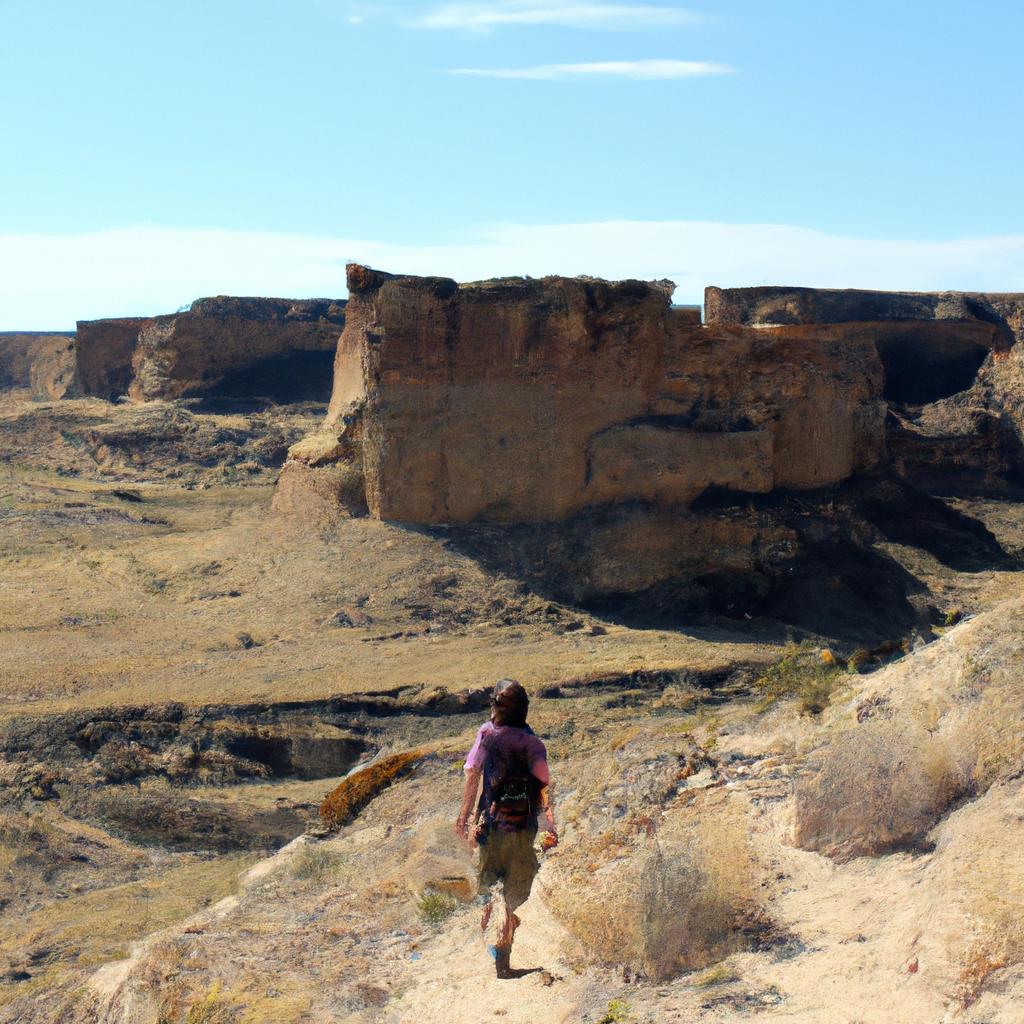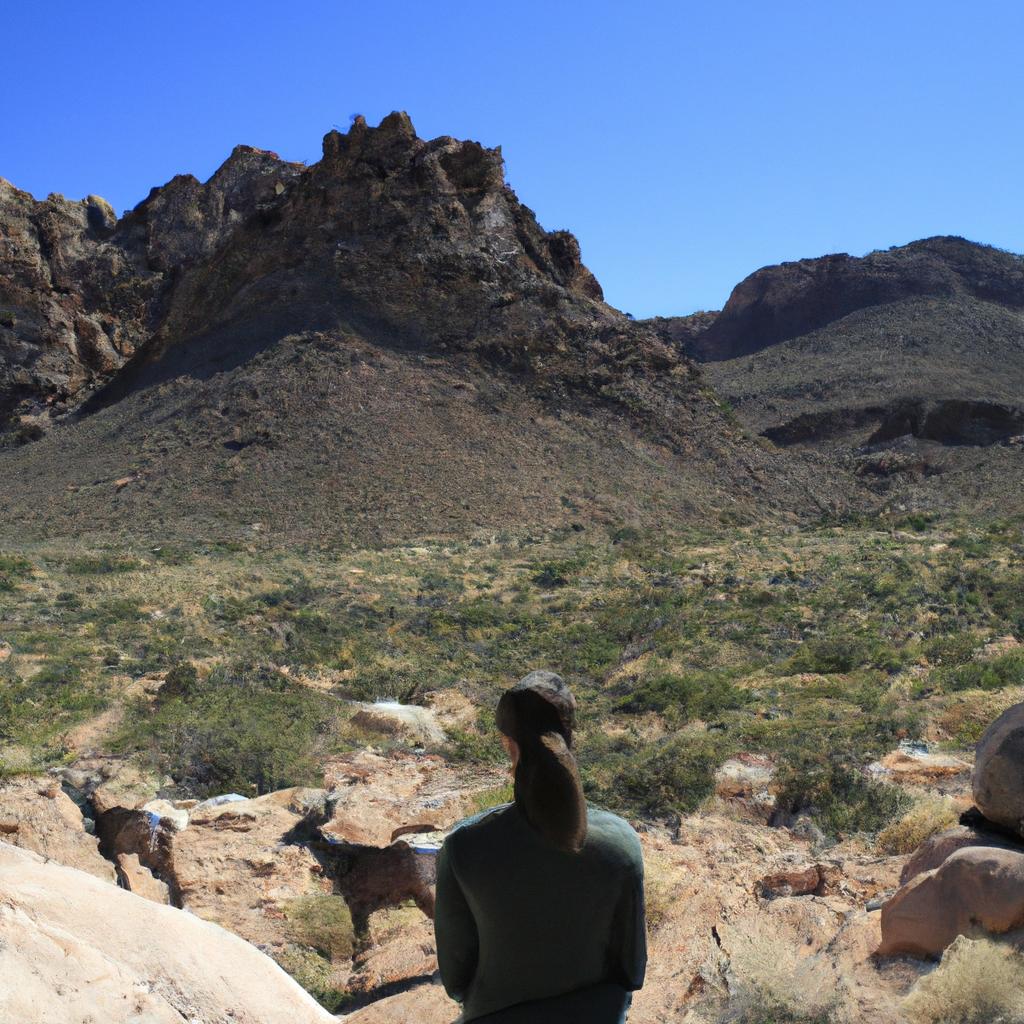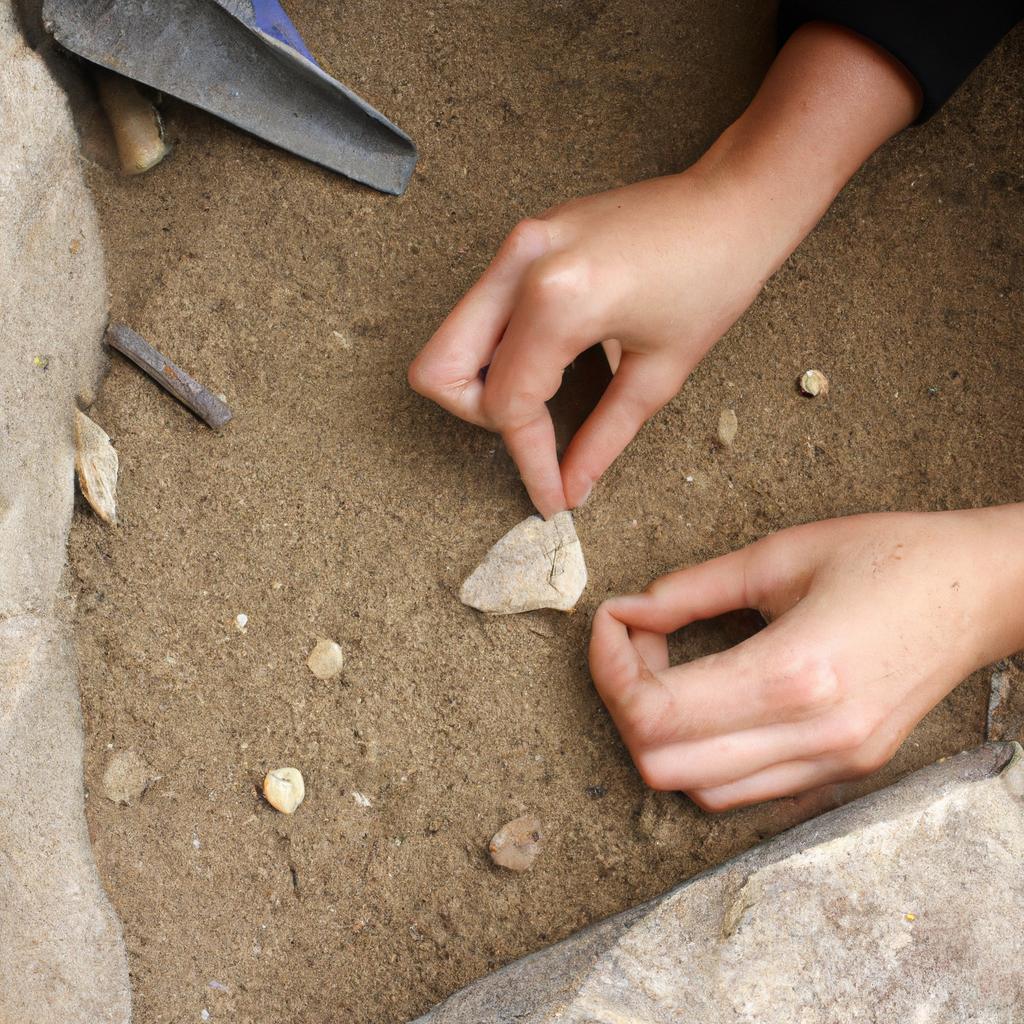Chaco Canyon, located in the southwestern region of the United States, is a site renowned for its rich history and archaeological significance. As travel photography continues to captivate audiences worldwide, it becomes imperative to explore the artistic elements that contribute to composition within this unique setting. By examining the interplay between subject placement, leading lines, and perspective, we can gain insight into how photographers utilize these compositional techniques to convey Chaco Canyon’s cultural essence.
Consider the case of a photographer standing before Pueblo Bonito, one of the largest and most iconic structures within Chaco Canyon. The choice of subject placement plays a crucial role in capturing the grandeur and historical significance of this ancient ruin. Placing Pueblo Bonito off-center rather than centered in the frame allows for a more dynamic composition. This deliberate decision not only adds visual interest but also creates space for other elements such as surrounding landscape or foreground details to enhance the overall narrative conveyed through the photograph.
Furthermore, leading lines serve as powerful tools in guiding viewers’ eyes towards key focal points within an image. In Chaco Canyon, where architectural structures are arranged with remarkable precision along cardinal directions, photographers can exploit these distinctive patterns to create captivating compositions. For instance, capturing a diagonal pathway leading towards a well or a ceremonial kiva can create a sense of depth and draw the viewer into the scene. These leading lines not only serve as visual guides but also highlight the interconnectedness and deliberate design found within Chaco Canyon, emphasizing its cultural importance.
Perspective is another crucial aspect to consider when photographing Chaco Canyon. By experimenting with different vantage points and angles, photographers can evoke different emotions and perspectives within their images. For instance, shooting from a low angle looking up at the towering walls of Pueblo Bonito can convey a sense of awe and emphasize the monumental scale of these ancient structures. On the other hand, capturing aerial shots from above can provide a unique perspective that showcases the vastness and layout of Chaco Canyon as a whole.
In summary, when photographing Chaco Canyon, careful consideration should be given to subject placement, leading lines, and perspective in order to capture its cultural essence effectively. By utilizing these compositional techniques, photographers can create visually appealing images that not only showcase the historical significance of this archaeological site but also engage viewers on an emotional level, inviting them to explore and appreciate this unique part of American history.
The Historical Significance of Chaco Canyon
Chaco Canyon, located in the southwestern United States, holds immense historical significance. Its ancient ruins and artifacts provide a glimpse into a complex and sophisticated civilization that thrived over a thousand years ago. One example that highlights this significance is the Great Kiva, an impressive ceremonial structure found at Pueblo Bonito.
To truly grasp the importance of Chaco Canyon, it is crucial to understand its architectural marvels. The Great Kiva at Pueblo Bonito stands as an exceptional testament to the engineering prowess of its builders. This circular underground chamber was used for various rituals and ceremonies by the Ancestral Puebloans. Its construction required careful planning and precise alignment with celestial events, showcasing their deep understanding of astronomy and cosmology.
Exploring the historical significance further, let us consider four key elements that evoke an emotional response when contemplating Chaco Canyon:
- Mystique: The enigmatic nature surrounding Chaco Canyon sparks curiosity and fascination among historians and visitors alike. It beckons us to unravel its secrets and invites contemplation about the lives led by those who inhabited this ancient city.
- Connection to Nature: Chaco Canyon’s location amidst stunning natural landscapes enhances our appreciation for how these early inhabitants adapted to their environment. The juxtaposition between human-made structures against the rugged desert backdrop creates a sense of harmony and awe.
- Cultural Legacy: By preserving and studying Chacoan remains, we honor the cultural legacy left behind by its ancient residents. Their achievements serve as a reminder of human ingenuity across time, inspiring admiration for their accomplishments.
- Spiritual Essence: Many believe that Chaco Canyon held spiritual significance for its inhabitants due to its alignment with astronomical phenomena like solstices and equinoxes. Visiting this site allows one to connect with history on a deeply spiritual level.
Additionally, examining the table below provides insight into some notable features of Chaco Canyon’s historical significance:
| Feature | Significance |
|---|---|
| Great Houses | Architectural wonders that showcase the advanced building skills |
| Petroglyphs | Ancient rock carvings depicting cultural and spiritual symbols |
| Road System | A complex network of roads connecting Chaco Canyon to other sites |
| Pottery and Artifacts | Precious remnants offering insights into daily life and customs |
Understanding the Rule of Thirds in Composition follows naturally from appreciating Chaco Canyon’s historical significance. By merging knowledge of this composition technique with an understanding of its cultural legacy, photographers can capture captivating images that pay homage to the rich history encapsulated within these ancient walls.
Understanding the Rule of Thirds in Composition
Composition in Travel Photography: Chaco Canyon’s Artistic Elements
The Historical Significance of Chaco Canyon highlighted the cultural and archaeological importance of this ancient site. Now, let us delve into the artistic elements that make Chaco Canyon a captivating subject for travel photography.
Imagine standing at the edge of Pueblo Bonito, one of the largest structures in Chaco Canyon. The grandeur and intricacy of its architecture immediately draw your attention. As you frame your shot, consider how composition can enhance the visual impact of this historical marvel. Here are some key aspects to focus on:
-
Leading Lines: Utilize the natural lines within the structure or surrounding landscape to guide viewers’ eyes towards specific points of interest. For instance, capture an image where the edges of Pueblo Bonito lead towards its central doorway, creating a sense of depth and perspective.
-
Rule of Thirds: Divide your frame into nine equal parts using two horizontal and vertical lines. Place significant elements such as doorways or windows along these lines or at their intersections, known as power points. This technique adds balance and dynamism to your composition.
-
Symmetry and Patterns: Explore symmetrical compositions by centering prominent architectural features or repeating patterns within your frame. This approach can evoke a sense of harmony and orderliness while highlighting intricate details found in Chacoan construction.
-
Scale and Perspective: Experiment with different vantage points to emphasize the vastness and scale of Chaco Canyon’s structures against the expansive desert backdrop. Consider capturing images from ground level, elevated positions, or even incorporating human figures to provide a reference point for size comparison.
By employing these compositional techniques effectively, you can create visually compelling photographs that showcase not only the historical significance but also the artistic allure of Chaco Canyon.
In our next section about “The Impact of Lighting on Travel Photography,” we will explore how lighting plays a crucial role in enhancing mood and capturing the essence of a location. Transitioning from composition to lighting, we will uncover how different lighting conditions in Chaco Canyon can transform your photographs into captivating works of art.
The Impact of Lighting on Travel Photography
Composition in Travel Photography: Chaco Canyon’s Artistic Elements
Understanding the Rule of Thirds is just the beginning when it comes to creating visually appealing travel photographs. To further enhance the artistic quality of your images, it is crucial to consider other elements of composition. In this section, we will explore how Chaco Canyon’s unique features can be utilized to create captivating compositions.
Imagine capturing a photograph at Chaco Canyon where an ancient pueblo stands majestically against the backdrop of a clear blue sky. By employing various compositional techniques, you can transform this scene into a truly remarkable image. One effective approach is utilizing leading lines to draw the viewer’s attention towards the pueblo. These lines could be formed by pathways or naturally occurring formations within the landscape, such as winding rivers or jagged cliffs. Applying leading lines not only adds depth and dimension to your photograph but also guides viewers’ eyes toward the focal point, creating a sense of visual harmony.
To fully grasp the significance of incorporating different elements into your composition at Chaco Canyon, consider these key points:
- Balance: Strive for equilibrium by distributing visual weight evenly throughout your frame. This ensures that no single element dominates the image while maintaining a pleasing aesthetic.
- Contrast: Play with contrasting elements like light and dark tones or textures to add visual interest and make certain aspects stand out.
- Symmetry/Asymmetry: Experiment with symmetrical compositions for formal scenes or asymmetrical ones for more dynamic environments, both offering distinct visual experiences.
- Framing: Utilize natural frames within Chaco Canyon—such as arches or doorways—to provide context and guide viewers’ focus on specific subjects.
By implementing these principles effectively, you can elevate your photography from ordinary snapshots to evocative works of art capable of conveying powerful emotions and narratives.
Utilizing Lines and Leading Lines in Chaco Canyon Photography
Incorporating lines effectively can greatly enhance your photographic compositions at Chaco Canyon. By strategically placing lines within your frame, you can guide viewers’ eyes and create a sense of depth and movement. Whether it’s the natural contours of the land or man-made structures, understanding how to utilize lines will allow you to capture stunning images that truly showcase the beauty of this ancient site.
Utilizing Lines and Leading Lines in Chaco Canyon Photography
Building upon the significance of lighting, another crucial aspect to consider when capturing captivating travel photographs at Chaco Canyon is the effective use of composition. By skillfully incorporating various artistic elements into your images, you can enhance their visual appeal and convey a sense of depth and meaning. In this section, we will explore how composition techniques help create compelling travel photography within the unique landscape of Chaco Canyon.
Paragraph 1:
To illustrate the impact of composition in travel photography, let us imagine a scenario where an adventurous photographer decides to capture the magnificence of Pueblo Bonito at sunset. Through careful consideration of composition techniques, such as rule of thirds or framing, they are able to emphasize the grandeur and historical importance of this ancient structure against the backdrop of a breathtaking desert landscape. By placing Pueblo Bonito off-center using the rule of thirds, for instance, they draw attention not only to its intricate architecture but also to the vastness and beauty that surrounds it.
Paragraph 2:
When exploring Chaco Canyon with a camera lens, there are several key compositional elements worth considering:
- Perspective: Experimenting with different angles and viewpoints can offer fresh perspectives on familiar subjects.
- Symmetry and Balance: Seeking out symmetrical patterns or striving for balanced compositions can evoke feelings of harmony and stability.
- Scale: Including human figures or other recognizable objects alongside monumental structures provides viewers with a sense of scale and awe.
- Negative Space: Intentionally leaving empty spaces around focal points can add drama and emphasis by drawing attention directly to them.
Embracing these principles allows photographers to artistically communicate their experience while immersing viewers in both an emotional connection with nature’s wonders and an appreciation for the cultural significance of Chaco Canyon.
Paragraph 3:
In their quest to capture the essence of Chaco Canyon, photographers must also take into account the textures that define this unique landscape. By artfully leveraging composition techniques discussed earlier, they can emphasize these distinct textural qualities – from the weathered sandstone walls of ancient structures to the intricate patterns etched by wind across sandy expanses. The following section will delve deeper into ways in which photographers can masterfully capture and highlight these extraordinary textures.
By utilizing various composition techniques, travel photographers can not only convey a sense of depth and meaning but also evoke emotional responses from viewers as they explore Chaco Canyon’s remarkable artistic elements. In the upcoming section, we will uncover how capturing its unique textures further enhances our visual journey through this captivating destination.
Capturing the Unique Textures of Chaco Canyon
By skillfully utilizing lines and leading lines, photographers can bring a dynamic element to their compositions at Chaco Canyon. Now, let us explore another crucial aspect that adds depth and interest to travel photography – capturing the unique textures found within this ancient site.
To truly convey the essence of Chaco Canyon through photography, it is essential to capture its distinct textures. Imagine an intriguing shot where sunlight softly illuminates the intricate patterns on a weathered adobe wall; or close-up imagery showcasing the rough edges of stacked sandstone blocks revealing centuries-old craftsmanship. These striking visual representations allow viewers to connect with the rich history ingrained within these textured surfaces.
When photographing Chaco Canyon’s textures, consider implementing techniques such as:
-
Contrast:
- Highlight the juxtaposition between smooth and rough surfaces.
- Emphasize variations in color intensity to create captivating visuals.
-
Depth:
- Experiment with different angles and focal lengths.
- Capture layers of texture by incorporating foreground elements.
-
Lighting:
- Observe how natural light interacts with various surfaces.
- Utilize shadows and highlights to enhance textural details.
-
Scale:
- Include subjects like human figures or objects for size comparison.
- Showcase vast expanses versus minute intricacies using compositional techniques such as framing or cropping.
Table (Markdown format):
| Techniques | Description |
|---|---|
| Contrast | Highlight differences between smooth and rough surfaces |
| Depth | Incorporate multiple layers of texture into your composition |
| Lighting | Use lighting to emphasize details on various surfaces |
| Scale | Play with size comparison to showcase the vastness or intricacies of textures |
As you explore Chaco Canyon’s unique textures through your lens, remember that capturing these elements not only adds visual interest but also evokes an emotional response in your audience. The rough and weathered surfaces tell stories of time, endurance, and human ingenuity. By skillfully showcasing these textural details within your photographs, you provide viewers with a palpable connection to the ancient past.
Transition into subsequent section “Creating a Sense of Scale in Chaco Canyon Photography”:
Now, let us delve into another crucial aspect: creating a sense of scale in Chaco Canyon photography. By incorporating elements that emphasize size and proportion, we can further enhance our compositions and convey the grandeur of this remarkable site without resorting to clichéd methods.
Creating a Sense of Scale in Chaco Canyon Photography
Capturing the Unique Textures of Chaco Canyon was just the beginning of unraveling the artistic elements that make this destination a photographer’s paradise. In order to further enhance the visual appeal and storytelling capability of your travel photography, it is essential to consider composition techniques that highlight both the grandeur and intricate details found within Chaco Canyon.
One effective way to add depth and interest to your photographs is by creating a sense of scale. By including human figures or recognizable objects in the frame, you can convey the immense size of the ancient structures and landscapes at Chaco Canyon. For instance, imagine capturing an image of a solitary hiker standing against the towering walls of Pueblo Bonito, emphasizing the sheer magnitude of these architectural achievements.
Additionally, utilizing leading lines can guide viewers’ eyes through your photograph, drawing attention to specific subjects or points of interest. The rugged landscape surrounding Chaco Canyon presents numerous opportunities for incorporating leading lines into your compositions. Picture a winding path cutting through mesas and buttes, guiding viewers towards a stunning sunset over Fajada Butte – this technique not only adds visual intrigue but also invites contemplation and exploration.
Furthermore, paying close attention to color contrast can help evoke different emotions within your audience. Consider using vibrant hues juxtaposed with earthy tones to create visually striking images that capture the essence of Chaco Canyon’s natural beauty. A bullet point list below summarizes some key considerations when working with color contrast:
- Utilize complementary colors (e.g., blue-orange) to create visual harmony.
- Experiment with contrasting warm and cool tones for added drama.
- Use color as a tool for highlighting focal points or subjects within your composition.
- Take advantage of golden hour lighting conditions to enhance color vibrancy.
To fully grasp how these compositional techniques can be applied in practice, refer to the table below which showcases various scenarios illustrating their implementation:
| Composition Technique | Scenario Description |
|---|---|
| Sense of Scale | A lone visitor gazing up at the towering walls of Chetro Ketl |
| Leading Lines | An ancient petroglyph trail guiding viewers towards Casa Rinconada |
| Color Contrast | Vibrant wildflowers contrasting against the red sandstone cliffs at Pueblo Alto |
By thoughtfully incorporating these composition techniques, your travel photography in Chaco Canyon can transcend mere snapshots and become powerful visual narratives that captivate and inspire your audience. Through scale, leading lines, and color contrast, you will be able to convey the magnificence and nuanced beauty of this remarkable archaeological site without relying on words or explanations.










